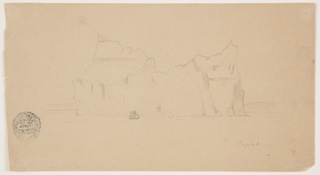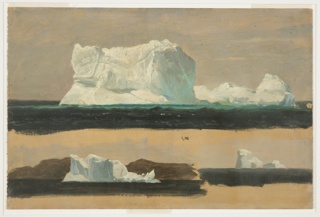After Icebergs
This exhibition was on display from November 16, 2019 to March 13, 2020.
Some objects in this exhibition may not be viewable on the website due to copyright or other usage restrictions, or because there is no digitized image for the object.
See all the exhibitions.
View and print exhibition labels.
In the summer of 1859, Frederic Edwin Church (1826–1900)—the most celebrated American landscape painter of his time—journeyed to Newfoundland and Labrador to study and sketch icebergs. Arctic exploration had captured the imagination of the public in the preceding decades, and Church was lured to the North Atlantic by accounts of a surreal polar landscape. To document the voyage, Church bought along Louis Legrand Noble, a clergyman and friend, who later published an account of the trip titled After Icebergs with a Painter. Moving day after day between a chartered schooner and a rowboat, Church grappled with how to capture the form, surface, colors, and motion of the icebergs before him and the luminous sea and sky that surrounded them. One hundred and sixty years later, Church's studies are at once seductive and frighteningly poignant. The icebergs found in today's oceans—caused by the melting of glaciers' edges—are a symptom of our rapidly warming Earth. These studies, drawn from Cooper Hewitt's collection of over 2,000 drawings by Church, offer us a moment to reflect with reverence on the fragility of our natural world.
- Drawing, Floating Icebergs
- graphite and white gouache on light brown paper.
- Gift of Louis P. Church.
- 1917-4-273-a
- This object is part of the Drawings, Prints, and Graphic Design collection.
- There are 3 images of this object.
- Drawing, Icebergs, Canada
- graphite and white gouache on light brown wove paper.
- Gift of Louis P. Church.
- 1917-4-273-b
- This object is part of the Drawings, Prints, and Graphic Design collection.
- There are 3 images of this object.
- Drawing, Four Floating Icebergs, Canada
- graphite and white gouache on light brown paper.
- Gift of Louis P. Church.
- 1917-4-273-c
- This object is part of the Drawings, Prints, and Graphic Design collection.
- There are 3 images of this object.
- Drawing, The Iceberg, Canada
- graphite on light brown wove paper.
- Gift of Louis P. Church.
- 1917-4-275-a
- This object is part of the Drawings, Prints, and Graphic Design collection.
- There are 3 images of this object.
- Drawing, Icebergs off Greenspond, Canada
- graphite and white gouache on light brown paper.
- Gift of Louis P. Church.
- 1917-4-275-b
- This object is part of the Drawings, Prints, and Graphic Design collection.
- There are 3 images of this object.
- Drawing, Icebergs near Cape St. John, Canada
- graphite and white gouache on light brown paper.
- Gift of Louis P. Church.
- 1917-4-277-a
- This object is part of the Drawings, Prints, and Graphic Design collection.
- There are 3 images of this object.
- Drawing, Five Floating Icebergs, Canada
- graphite and white gouache on light brown wove paper.
- Gift of Louis P. Church.
- 1917-4-277-b
- This object is part of the Drawings, Prints, and Graphic Design collection.
- There are 3 images of this object.
- Drawing, Five Floating Icebergs, Canada
- graphite and white gouache on light brown wove paper.
- Gift of Louis P. Church.
- 1917-4-277-c
- This object is part of the Drawings, Prints, and Graphic Design collection.
- There are 3 images of this object.
- Drawing, Iceberg Sketches, Canada
- graphite and white gouache on light brown paper.
- Gift of Louis P. Church.
- 1917-4-284-c
- This object is part of the Drawings, Prints, and Graphic Design collection.
- There are 3 images of this object.
- Drawing, Iceberg in Cartwright's Bight, Southwest from Battle Harbor, Canada
- brush and oil paint, graphite on tan paperboard.
- Gift of Louis P. Church.
- 1917-4-289-a
- This object is part of the Drawings, Prints, and Graphic Design collection.
- There are 2 images of this object.
- Drawing, Two Icebergs, Canada
- oil and graphite on paperboard.
- Gift of Louis P. Church.
- 1917-4-290-a
- This object is part of the Drawings, Prints, and Graphic Design collection.
- There are 2 images of this object.
- Drawing, Icebergs, Tonilliguet
- oil and graphite on tan paperboard.
- Gift of Louis P. Church.
- 1917-4-294-a
- This object is part of the Drawings, Prints, and Graphic Design collection.
- There are 4 images of this object.
- Drawing, Floating Iceberg, Canada
- oil and graphite on tan paperboard.
- Gift of Louis P. Church.
- 1917-4-296-a
- This object is part of the Drawings, Prints, and Graphic Design collection.
- There are 3 images of this object.
- Drawing, Iceberg and Ice Flower, Canada, June–July 1859
- brush and oil paint, graphite on tan paperboard.
- Gift of Louis P. Church.
- 1917-4-296-b
- This object is part of the Drawings, Prints, and Graphic Design collection.
- There are 3 images of this object.
- Drawing, Iceberg, St. Lewis Bay, Newfoundland, July 7-8, 1859
- oil and graphite on paperboard.
- Gift of Louis P. Church.
- 1917-4-296-c
- This object is part of the Drawings, Prints, and Graphic Design collection.
- There are 3 images of this object.
- Drawing, Foundering Icebergs near Battle Harbour, Canada
- graphite and white gouache on light green wove paper.
- Gift of Louis P. Church.
- 1917-4-297-a
- This object is part of the Drawings, Prints, and Graphic Design collection.
- There are 2 images of this object.
- Drawing, Iceberg Under Cloudy Skies, Canada
- oil and graphite on tan paperboard.
- Gift of Louis P. Church.
- 1917-4-305-a
- This object is part of the Drawings, Prints, and Graphic Design collection.
- There are 2 images of this object.
- Drawing, Iceberg Under Cloudy Skies, Canada, June–July 1859
- brush and oil paint, graphite on tan paperboard.
- Gift of Louis P. Church.
- 1917-4-305-b
- This object is part of the Drawings, Prints, and Graphic Design collection.
- There are 3 images of this object.
- Drawing, Iceberg near Cape Race, Canada
- graphite and white gouache on light brown paper.
- Gift of Louis P. Church.
- 1917-4-319-a
- This object is part of the Drawings, Prints, and Graphic Design collection.
- There are 4 images of this object.
- Drawing, Two Floating Icebergs, Canada
- graphite and white gouache on light brown wove paper.
- Gift of Louis P. Church.
- 1917-4-365-a
- This object is part of the Drawings, Prints, and Graphic Design collection.
- There are 3 images of this object.
- Drawing, Island off Henley Harbour with Two Floating Icebergs, Canada
- graphite on light brown wove paper.
- Gift of Louis P. Church.
- 1917-4-366-a
- This object is part of the Drawings, Prints, and Graphic Design collection.
- There are 3 images of this object.
- Drawing, Iceberg at Midnight, Labrador
- oil on tan paperboard.
- Gift of Louis P. Church.
- 1917-4-711
- This object is part of the Drawings, Prints, and Graphic Design collection.
- There are 3 images of this object.
- Drawing, Iceberg off Torbay, Canada
- brush and oil paint, graphite on paperboard.
- Gift of Louis P. Church.
- 1917-4-714-b
- This object is part of the Drawings, Prints, and Graphic Design collection.
- There are 3 images of this object.
- Drawing, Iceberg Against the Evening Sky, Canada
- oil and graphite on paperboard.
- Gift of Louis P. Church.
- 1917-4-731
- This object is part of the Drawings, Prints, and Graphic Design collection.
- There are 3 images of this object.
- Drawing, Seascape with Iceberg
- oil and graphite on paperboard.
- Gift of Louis P. Church.
- 1917-4-745-a
- This object is part of the Drawings, Prints, and Graphic Design collection.
- There are 3 images of this object.
- Drawing, Distant Iceberg, Canada
- oil and graphite on paperboard.
- Gift of Louis P. Church.
- 1917-4-745-b
- This object is part of the Drawings, Prints, and Graphic Design collection.
- There are 3 images of this object.
- Drawing, Gray Iceberg, Canada
- oil and graphite on tan paperboard.
- Gift of Louis P. Church.
- 1917-4-749-a
- This object is part of the Drawings, Prints, and Graphic Design collection.
- There are 3 images of this object.
- Drawing, Sketch of an Iceberg
- graphite on light blue wove paper; verso: graphite.
- Gift of Louis P. Church.
- 1917-4-1102
- This object is part of the Drawings, Prints, and Graphic Design collection.
- There are 4 images of this object.
- Drawing, Four Floating Icebergs, Canada
- graphite on white laid paper.
- Gift of Louis P. Church.
- 1917-4-1196
- This object is part of the Drawings, Prints, and Graphic Design collection.
- There are 3 images of this object.
- Book, After Icebergs with a Painter: A Summer Voyage to Labrador and around...
- book.
- Courtesy Smithsonian Institution Libraries.
- 11.2019.1
- There are 6 images of this object.
- Drawing, Sketches from Newfoundland and Labrador, Canada
- graphite and white gouache on light brown paper.
- Gift of Louis P. Church.
- 1917-4-321
- This object is part of the Drawings, Prints, and Graphic Design collection.
- There are 3 images of this object.
- Drawing, Coastline Cliffs of Great Island, Newfoundland and Labrador, Canada
- graphite and white gouache on light brown paper.
- Gift of Louis P. Church.
- 1917-4-448
- This object is part of the Drawings, Prints, and Graphic Design collection.
- There are 2 images of this object.
- Drawing, Icebergs at Sea near Newfoundland, Canada
- graphite and white gouache on light green wove paper.
- Gift of Louis P. Church.
- 1917-4-298
- This object is part of the Drawings, Prints, and Graphic Design collection.
- There are 2 images of this object.
- Drawing, Sketches from Newfoundland and Labrador, Canada
- graphite, brush and white gouache on light brown paper.
- Gift of Louis P. Church.
- 1917-4-363
- This object is part of the Drawings, Prints, and Graphic Design collection.
- There are 3 images of this object.
- Drawing, Four Floating Icebergs, Canada
- graphite on light brown wove paper.
- Gift of Louis P. Church.
- 1917-4-365-b
- This object is part of the Drawings, Prints, and Graphic Design collection.
- There are 3 images of this object.
- Drawing, The Last Iceberg, Canada
- graphite on light brown wove paper.
- Gift of Louis P. Church.
- 1917-4-365-c
- This object is part of the Drawings, Prints, and Graphic Design collection.
- There are 3 images of this object.



































